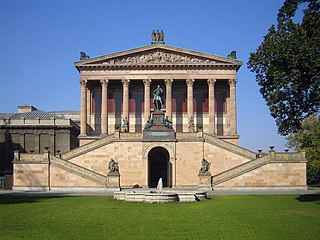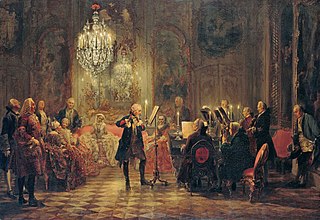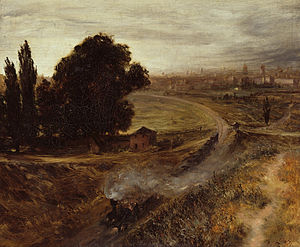
Max Liebermann was a German painter and printmaker, and one of the leading proponents of Impressionism in Germany and continental Europe. In addition to his activity as an artist, he also assembled an important collection of French Impressionist works.

Adolph Friedrich Erdmann von Menzel was a German Realist artist noted for drawings, etchings, and paintings. Along with Caspar David Friedrich, he is considered one of the two most prominent German painters of the 19th century, and was the most successful artist of his era in Germany. First known as Adolph Menzel, he was knighted in 1898 and changed his name to Adolph von Menzel.

The Alte Nationalgalerie is a listed building on the Museum Island in the historic centre of Berlin, Germany. The gallery was built from 1862 to 1876 by the order of King Frederick William IV of Prussia according to plans by Friedrich August Stüler and Johann Heinrich Strack in Neoclassical and Renaissance Revival styles. The building's outside stair features a memorial to Frederick William IV. Currently, the Alte Nationalgalerie is home to paintings and sculptures of the 19th century and hosts a variety of tourist buses daily. As part of the Museum Island complex, the gallery was inscribed on the UNESCO World Heritage List in 1999 for its outstanding architecture and its testimony to the development of museums and galleries as a cultural phenomenon in the late 19th century.

Teltow [German pronunciation:['tɛltoː] ] is a town in the Potsdam-Mittelmark district, in Brandenburg, Germany.

Lotte Laserstein was a German-Swedish painter. She was an artist of figurative paintings in Germany's Weimar Republic. The National Socialist regime and its anti-Semitism forced her to leave Germany in 1937 and to emigrate to Sweden. In Sweden, she continued to work as a portraitist and painter of landscapes until her death. The paintings she created during the 1920s and 1930s fit into the movement of New Objectivity in Germany.

Studio Wall (1872) is an oil painting by the German artist Adolph Menzel, now in the collection of the Hamburger Kunsthalle. It is considered a masterpiece of his maturity, which he deemed his best painting.

Hans Baluschek was a German painter, graphic artist and writer.

The first section of the Berlin–Magdeburg Railway was opened in 1838 as the Berlin-Potsdam Railway and was the first railway line in Prussia. In 1846 it was extended to Magdeburg.

The Wannsee Railway is a suburban railway in Berlin running from Potsdamer Platz via the Ring line station of Schöneberg to Wannsee station on Großer Wannsee, a lake after which it is named. Today it is a section of the Berlin S-Bahn line S1.

The Frankfurt (Oder) station is the main passenger station in Frankfurt (Oder). It is one of the most important railway stations in the German state of Brandenburg. It is served by regional and long-distance services and since 1945 it has been a border station for transport to and from Poland. The station has been substantially rebuilt several times. A building on the grounds of the first Frankfurt station, north of the current station, is heritage-listed, as are the Kiliansberg apartments, which were built as a railway settlement at the station forecourt, and a monument to railwaymen who fell in the First World War in the same area.

The Märchenbrunnen is located in the Volkspark Friedrichshain in Berlin. In 1893 the authorities of Berlin issued the artistic entrance to the National Park Friedrichshain. The fountain of fairy tales was commissioned by the National Park and later designed by Ludwig Hoffmann. Hoffmann put forward the idea of a fountain in the park to depict fairy tales. Hoffmann describes this in his memoirs.

Realism was an artistic movement that emerged in France in the 1840s, around the 1848 Revolution. Realists rejected Romanticism, which had dominated French literature and art since the early 19th century. Realism revolted against the exotic subject matter and the exaggerated emotionalism and drama of the Romantic movement. Instead, it sought to portray real and typical contemporary people and situations with truth and accuracy, and not avoiding unpleasant or sordid aspects of life. The movement aimed to focus on unidealized subjects and events that were previously rejected in art work. Realist works depicted people of all classes in situations that arise in ordinary life, and often reflected the changes brought by the Industrial and Commercial Revolutions. Realism was primarily concerned with how things appeared to the eye, rather than containing ideal representations of the world. The popularity of such "realistic" works grew with the introduction of photography—a new visual source that created a desire for people to produce representations which look objectively real.

Annot, also known after her marriage as Annot Jacobi, was a German painter, art teacher, art writer and pacifist. As a result of political hostility in Germany, she spent much of her life in the United States and Puerto Rico.

Frederick the Great Playing the Flute at Sanssouci or The Flute Concert is an 1852 oil on canvas history painting by the German painter Adolph Menzel. It depicts Frederick the Great, King of Prussia playing the flute at an evening concert at Sanssouci and is now in the Alte Nationalgalerie in Berlin.
Paul Ehrhardt was a German painter.

Max Friedrich Koch was a German history painter. Later as professor he taught art at the Unterrichtsanstalt des Kunstgewerbemuseums Berlin ; head of the academic master's studio for monumental painting, theatrical and decorative painting.

The Balcony Room is an oil-on-canvas painting by the German artist Adolph Menzel, executed in 1845. It is one of the main works of his early period and one of his most famous paintings. It has belonged to the collection of the Alte Nationalgalerie in Berlin, since 1903.

Departure of King Wilhelm I for the Army, July 31, 1870 is an oil on canvas painting by German artist Adolph Menzel, created in 1871. It depicts a scene that takes place in the avenue Unter den Linden, in Berlin, where a crowd is paying tribute to King Wilhelm I of Prussia, as he passes in an open carriage, on his way to the Franco-Prussian War, who had started two weeks earlier. The painting is part of the collection of the Alte Nationalgalerie, in Berlin, since 1881.

The Iron Rolling Mill (Modern Cyclopes) is an oil on canvas painting by German artist Adolph Menzel, created in 1872-1875. The painting is one of his main works from the time when the painter was mostly concerned with contemporary issues and the social question as a result of the uninhibited technical advances made during the Industrial Revolution, particularly in Germany. It has the large dimensions of 158 by 254 cm. The signature of the artist can be seen at the lower left: "Signatur Adolph Menzel. Berlin 1875". The realistic painting caused a stir at the time and is now part of the collection of the Alte Nationalgalerie, in Berlin.


















